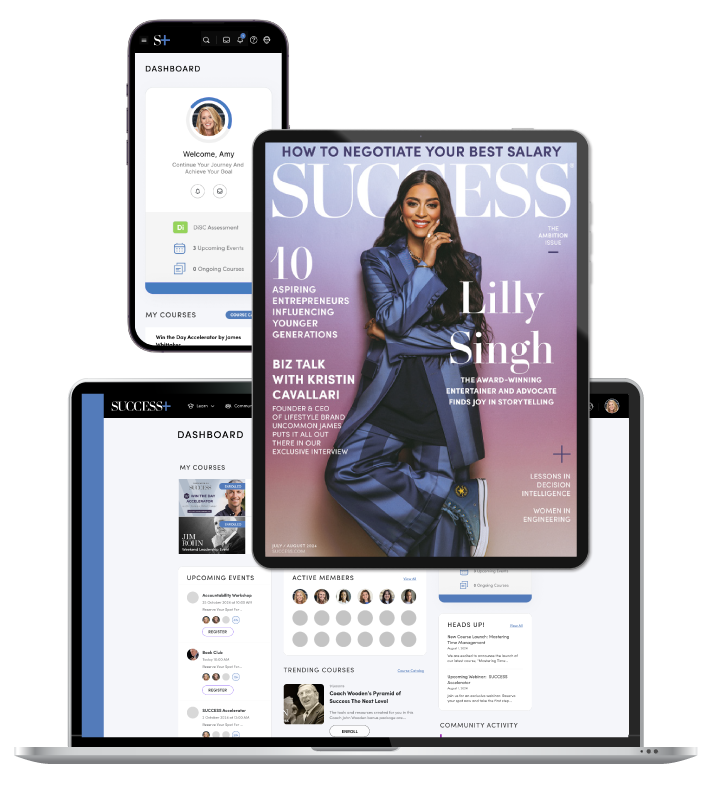
views
Quick Links
SECTIONS
- Business
- Entertainment
- Future of Work
- Health & Wellness
- Lifestyle
- Money
- Personal Development
- Professional Development
- Relationships
- SUCCESS Bestsellers
- Business
- Entertainment
- Future of Work
- Health & Wellness
- Lifestyle
- Money
- Personal Development
- Professional Development
- Relationships
- SUCCESS Bestsellers
JOIN US
- SUCCESS+
- SUCCESS Coaching
- Speakers Bureau
- SUCCESS Events
- SUCCESS Space
- Newsletter
- Daily SMS
- Subscribe
- Shop the SUCCESS Store
- SUCCESS+
- SUCCESS Coaching
- Speakers Bureau
- SUCCESS Events
- SUCCESS Space
- Newsletter
- Daily SMS
- Subscribe
- Shop the SUCCESS Store
GET IN TOUCH
CONNECT
Instagram Facebook Tiktok Linkedin Pinterest X-twitterMORE
 Get SUCCESS® Magazine PLUS 80+ Hours of Exclusive Training (& More!) to Multiply Your Earning Potential
SUBSCRIBE TODAY!
Get SUCCESS® Magazine PLUS 80+ Hours of Exclusive Training (& More!) to Multiply Your Earning Potential
SUBSCRIBE TODAY!
Save Up to 20% Before Oct. 2!
BOOKMARK Share TABLE OF CONTENTS
TABLE OF CONTENTS


If you want to level up your career but don’t know where to start, a professional development plan (PDP) might be your best bet. Whether you aim to learn a new skill for your current role or jump to a new job, a PDP can help you meet short- and long-term career goals more efficiently and effectively.
In this guide, we’ll cover the main components of a professional development plan, how to draft one using our professional development plan template and how to use a PDP to your advantage.
A professional development plan is a structured framework that outlines your career goals and the steps necessary to achieve them. While PDPs are often created by managers to support employees’ growth and align with organizational objectives, you can also create one yourself to map out your career goals and track your progress.
A PDP can be as simple as a text file or as structured as a table. It serves as a “living” document that is reviewed regularly, such as during quarterly check-ins or annual performance reviews, to track progress and make adjustments as needed.
Creating a plan is the first step toward professional development, career advancement and lasting success. A PDP is an opportunity for meaningful self-assessment—an honest, disciplined reflection of where you are now, what you truly want to achieve and the steps needed to get there.
This personal reflection will eliminate ambiguity with clearly defined objectives that keep you anchored as you progress. It’ll give you full control of your trajectory, empowering you to advance your career with calm and discipline.
A professional development plan also illuminates the tools and skills necessary to achieve your goals. By identifying your skill gaps and how to address them, you’ll know exactly where to focus your energy. Acquiring new knowledge will increase your value, job performance and satisfaction. Whether you’re an employee or an entrepreneur, your new skills will contribute to organizational growth.
In its initial phase, a PDP inventories your current skills and knowledge. Based on that assessment, you can define incremental, actionable steps to achieve short- and long-term career goals within established time frames. These steps might include earning new certifications, learning new skills through professional development courses, finding mentors or expanding your professional network. These steps provide a road map for your desired career path.
As with any major project, your goals should be specific, measurable, achievable, relevant and time-bound. This SMART goal-setting strategy provides the structure needed to remain motivated, with clearly defined metrics for success and completion.
This professional development plan template serves as a blueprint for achieving your career goals. It includes five key components:
Here’s a breakdown of each component along with an action plan for completion:
Self-assessment is the starting point of all professional growth. Whether you’re creating a professional development plan for yourself or with the help of your manager, it’s important to be honest about where you are compared to where you want to be. That being said, it’s also important to not be too hard on yourself. Professional development plans should motivate and not discourage you from your professional goals.
Begin with a deep self-assessment to identify your career goals. Then, perform a SWOT analysis to determine your personal strengths, weaknesses, opportunities and threats as they pertain to your objectives. By acknowledging your existing assets and areas of improvement, you can better tailor your plan to align with your career goals.
The goals you set in your professional development plan should be SMART (Specific, Measurable, Achievable, Relevant and Time-bound). With your goals in mind, you can begin to outline your professional development plan.
Each goal should build upon the last, making you more capable of the role you desire over time. By setting clear objectives and breaking them into smaller, attainable goals, you’ll develop a road map that motivates you and allows you to track your progress regularly.
Remember that there’s nothing wrong with changing direction along the way or needing to modify your goals. Sometimes a change in direction can lead to even better personal and professional development.
Strategic skill development will help you close the gap between where you are and where you want to be. While not everyone’s approach will look the same, you should embrace experimentation, learning from others, education and reflection.
Developing new skills allows you to build upon your existing competencies and develop new ones. You can also expand your skillset outside of your current field through cross-departmental training, which creates opportunities for strategic partnerships.
Networking is a vital element in any professional development plan. By building and nurturing relationships, you expose yourself to diverse ideas while opening doors to future business connections. It can also provide the moral support and insight you need when faced with unexpected challenges.
If you struggle with networking, we recommend reading books like Never Eat Alone, Expanded and Updated: And Other Secrets to Success, One Relationship at a Time by Keith Ferrazzi, or Taking the Work Out of Networking: An Introvert’s Guide to Making Connections That Count by Karen Wickre.
Self-evaluation is an ongoing process within any professional development plan. It involves honestly assessing your achievements, the time required to reach your goals and the areas that need improvement. You can also ask others for feedback, which can help adjust your plan to meet evolving workplace demands.
A professional development plan isn’t just a document—it’s your personalized blueprint for success. By setting clear goals, building new skills and fostering strategic connections, you’ll gain the tools to advance your career with confidence and purpose.
Start drafting your plan today, and take the first step toward achieving your aspirations. Your future self will thank you!
This article was updated December 2024. Photo courtesy of Ground Picture/Shutterstock
5473 Blair Road, Suite 100
PMB 30053
Dallas, TX 75231
Copyright © 2024 SUCCESS Magazine. All rights reserved.
Save Up to 20% Before Oct. 2!
Copyright © 2024 SUCCESS Magazine. All rights reserved.
Unlock the Latest Knowledge that Can You Help You Achieve More in Life with More Confidence
Print and Digital Options Available
Oops!
You’ve reached your limit of free
articles for this month!
(plus get access to hundreds of resources designed
to help you excel in life and business)
Please enter your username or email address. You will receive an email message to log in.
No, thanks, I’m not interested in personal growth.
Plus, get access to daily inspiration, weekly newsletters and podcasts, and occasional updates from us.
By signing up you are also added to SUCCESS® emails. You can easily unsubscribe at anytime. By clicking above, you agree to our Privacy Policy and Terms of Use.
Please enter your username or email address. You will receive an email message to log in.
Get unlimited access to SUCCESS®
(+ a bunch of extras)! Learn more.
Please enter your username or email address. You will receive an email message to log in.
The exclusive article you’re trying to view is for subscribers only.
(plus get access to hundreds of resources designed
to help you excel in life and business)
Please enter your username or email address. You will receive an email message to log in.
https://www.success.com/professional-development-plan/

























Comments
0 comment